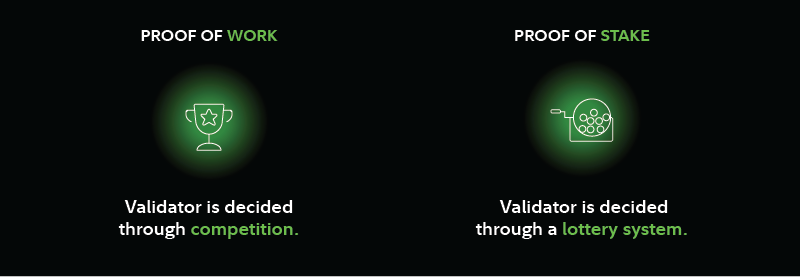The proof of work vs. proof of stake debate involves important topics, including decentralization, transaction speeds, and the environment. It's a critical discussion with implications that may affect the future of crypto.
At first glance, proof of work and proof of stake may not seem easy to understand. The good news is that breaking it down into simple language can make the details more digestible.
Let's take a closer look at exactly what all this debate is about.
What is proof of work and proof of stake?
Remember that crypto runs on blockchains, which are like giant spreadsheets that keep track of transactions (e.g., John sent Jane 0.01 bitcoin), as well as who owns how much cryptocurrency. Blockchains are updated in groups of transactions, and these transactions are added to their respective blockchains by millions of individuals or companies running special computers. The owners of these computers are paid by the blockchain in the cryptocurrency that they are updating.
The question, of course, is which computer gets to carry out the update. The system the blockchain uses to choose the updater is called a "consensus mechanism." Most consensus mechanisms currently use either proof of work or proof of stake.

Proof of work
Under proof of work, the updater (also called a "miner") is chosen via competition.
Here's how it works. For each group of transactions, the blockchain assigns a complex puzzle that can only be solved with brute computing power. One way to think of this puzzle is like a random locker combination with 1 million numbers.
Whoever guesses the combination correctly first gets to update the ledger with that specific collection of transactions. To participate in this competition, you need a powerful computer that guesses as many possible combinations of numbers as quickly as possible.
Proof of stake
Under proof of stake, however, the updater (also called a "validator") is chosen by chance.
In this system, holders of the cryptocurrency can choose to "stake" their coins. Think of staking like depositing money in a special bank account. Coins that are staked are locked in this account and can't be used for anything else unless you choose to withdraw them.
For each group of transactions, the blockchain randomly chooses one person with staked cryptocurrency to update the ledger. So while proof of work relies on competition, proof of stake operates more like a lottery system.
Potential advantages of proof of work
Supporters believe proof of work is more decentralized than other consensus mechanisms. One argument from this perspective is that there are practical limits to how much mining power one can acquire in a proof of work system. Mining requires enormous amounts of computing power, which requires computer chips and electricity. If someone wanted to manipulate a large proof of work-based blockchain like Bitcoin, they would need to first control a majority of the computer chip supply chain, then have access and funds to supply the necessary electricity.
Advocates argue that this link to real-world resources and constraints helps make it impractical for a single entity to manipulate the system. In contrast, proof of stake has a much smaller real-world link. To manipulate a proof of stake system, one would only need to buy and stake a majority of the available coins—no supply chains or electricity necessary.
Another argument supporters champion is that proof of work is currently more reliable because it's the oldest consensus mechanism. For example, the first cryptocurrency, Bitcoin, has operated on proof of work since it launched in 2009. As of July 2025, it has run for over a decade without its blockchain being successfully attacked or manipulated.
Potential disadvantages of proof of work
One critique of proof of work is the impact its energy usage has on the environment. Supporters believe the network's energy consumption is increasingly shifting toward renewable sources, but critics question whether its perceived positives justify the carbon emissions.
Another criticism is that it also requires large data centers to run, as well as bulky equipment that needs to be maintained, both of which create a large physical footprint. Additionally, these data centers need to be located in countries that allow mining, which can open doors for political risks.
A third criticism of proof of work is that it can be slow. For example, the Bitcoin network (proof of work) takes about 10 minutes on average to create a new block on its blockchain, whereas the Ethereum network (proof of stake) currently takes about 12 seconds. Bitcoin's processing speeds with proof of work could be less practical for everyday use.
Potential advantages of proof of stake
Proof of stake supporters believe the system has several advantages, the first of which is accessibility. You don't need to buy powerful computers or pay high electricity bills in order to have a chance to update a proof of stake blockchain. Instead, you simply need to buy and stake the coin. Proof of work advocates see this as a downside, but proof of stake supporters believe it's a strength, as it allows anyone to participate from the comfort of their laptop.
Supporters also note that it has a much smaller physical footprint than proof of work, as it doesn't require large data centers to maintain. In the same vein, it requires less power because it chooses its updaters based on chance rather than computing power. In 2022, the Ethereum network's shift from proof of work to proof of stake significantly dropped its energy usage.1
A third advantage proof of stake advocates point to is processing efficiency. Without the need to solve complex puzzles with brute computing power, proof of stake transactions can be verified and updated more quickly. As mentioned above, the Bitcoin network (proof of work) takes about 10 minutes on average to create a new block on its blockchain, whereas the Ethereum network (proof of stake) currently takes about 12 seconds on average.2,3
Potential disadvantages of proof of stake
Proof of work operates on competition, which means miners must consistently improve their equipment to have a chance to update the ledger. With proof of stake, however, one only needs to buy and hold the coins to have a chance. Critics believe these lower barriers can make proof of stake systems easier to manipulate.
In a similar vein, under proof of work systems like Bitcoin, owning the coins does not give the holder more power. In proof of stake, however, the more coins you own, the greater your voting power. Critics argue this leads to a "the rich get richer" situation, resulting in a less decentralized system.
Finally, critics also caution that proof of stake is a newer, less-proven system, and could face unforeseen attacks down the road. The system was first implemented in 2012, and wasn't used on a scale comparable to Bitcoin until the Ethereum network's shift to proof of stake in 2022. Moreover, the codes that power Ethereum's proof of stake mechanisms are more complex, which may create more risks. It remains to be seen whether it can match proof of work's relative longevity.
What to consider when choosing between proof of work cryptocurrencies and proof of stake cryptocurrencies
If you've done the research, understand the risks, and have decided crypto is right for you, note that currently, both proof of work and proof of stake coins experience volatility. Neither system makes it more likely a coin will increase in value or drop to zero.
It may be helpful to keep this in mind before buying crypto. One strategy that may help reduce your portfolio risk is to only buy an amount you can afford to lose. This may help reduce stress in the event a consensus mechanism experiences unforeseen developments.


